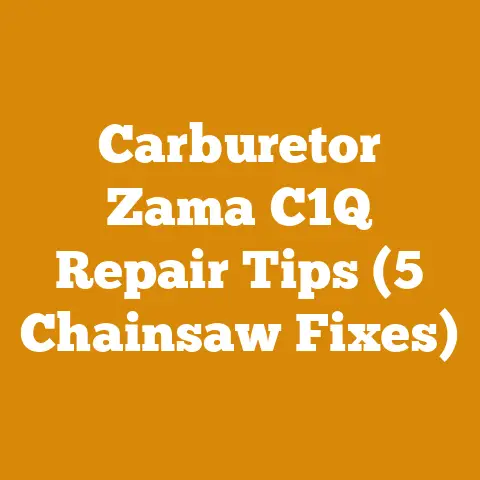372 XP Specs Comparison (5 Pro Tips for Choosing Your Saw)
The cold bites deep, doesn’t it?
I remember one winter, the snow piled so high I couldn’t even see the woodpile.
That’s when I learned a hard lesson: preparedness isn’t just about having the right tools, it’s about knowing them inside and out.
It’s about understanding their strengths, their weaknesses, and how they fit into your grand plan for conquering the wood.
And that’s where the Husqvarna 372 XP comes in.
It’s a legend, a workhorse, but is it your workhorse?
Choosing the right chainsaw is like choosing the right partner – it can make all the difference between a smooth, efficient operation and a back-breaking, frustrating ordeal.
This article isn’t just about specs; it’s about finding your perfect saw.
I’m going to share my own experiences, the mistakes I’ve made, and the hard-won wisdom I’ve gathered over years of wrestling with logs.
We’ll dive deep into the 372 XP, compare it to its rivals, and equip you with 5 pro tips to confidently choose the chainsaw that will become an extension of your own two hands.
Let’s get started, shall we?
The Husqvarna 372 XP: A Legend Examined
Let’s be honest, if you’re even considering the 372 XP, you’ve probably heard the whispers.
“Bulletproof,” “powerhouse,” “old reliable.” And there’s a reason for that.
This saw, despite being somewhat older technology compared to newer models, holds a special place in the hearts of many loggers and serious firewood enthusiasts.
But before you jump on the bandwagon, let’s break down what makes this saw tick.
372 XP: Key Specs and What They Mean
- Engine Displacement: 70.7 cc
- My Take: This is the heart of the beast.
That large displacement translates to raw power, capable of handling hardwoods and larger diameter logs with relative ease.
It’s not the most fuel-efficient, but you’re paying for brute strength.
- My Take: This is the heart of the beast.
- Power Output: 3.9 kW (5.3 hp)
- My Take: Horsepower is king, especially when you’re felling trees or bucking large rounds.
This saw delivers plenty of it.
- My Take: Horsepower is king, especially when you’re felling trees or bucking large rounds.
- Weight (Powerhead Only): 6.1 kg (13.4 lbs)
- My Take: This is where the 372 XP shows its age.
It’s not the lightest saw on the market.
A lighter saw might be better if you are doing limbing or smaller jobs.
This heft is a trade-off for its durability and power.
- My Take: This is where the 372 XP shows its age.
- Recommended Bar Length: 16″ – 24″
- My Take: Versatility is key.
I’ve run everything from an 18″ bar for general firewood cutting to a 20″ bar for larger trees.
The engine has the grunt to handle it.
- My Take: Versatility is key.
- Chain Pitch: .325″ or 3/8″
- My Take: This refers to the spacing between the chain links.
.325″ is common for general use, while 3/8″ is often preferred for larger timber.
- My Take: This refers to the spacing between the chain links.
- Fuel Tank Volume: 0.75 liters (25.4 fl oz)
- My Take: A decent size for the engine displacement, but you’ll still be refueling more often than with a smaller saw.
- Oil Tank Volume: 0.4 liters (13.5 fl oz)
- My Take: Keep an eye on the oil level.
A dry chain is a recipe for disaster.
- My Take: Keep an eye on the oil level.
The 372 XP: Strengths and Weaknesses
Strengths:
- Power: Unmatched in its class.
This saw can chew through almost anything you throw at it. - Durability: Built like a tank.
These saws are known for their longevity and ability to withstand harsh conditions.
I’ve seen 372 XPs still running strong after decades of hard use. - Reliability: Simple design means fewer things to go wrong.
I’ve always found them easy to maintain and repair. - Availability of Parts: Because it’s a popular model, parts are readily available, both OEM and aftermarket.
- Proven Track Record: It’s a tried-and-true design that has been proven in the field for years.
Weaknesses:
- Weight: It’s a heavy saw, which can be tiring for extended use.
- Fuel Efficiency: Not the most fuel-efficient saw on the market.
- Emissions: Older models may not meet current emissions standards in some areas.
- Vibration: Can be a bit rough on the hands, especially compared to newer saws with advanced anti-vibration systems.
- Cold Starts: Can sometimes be a bit finicky to start in cold weather.
The Competition: 372 XP vs. The Field
The 372 XP doesn’t exist in a vacuum.
Here’s how it stacks up against some of its rivals:
Husqvarna 572 XP: The Modern Contender
- Engine Displacement: 70.6 cc (very similar to the 372 XP)
- Power Output: 4.3 kW (5.8 hp)
- Weight (Powerhead Only): 6.6 kg (14.5 lbs)
- Key Differences: The 572 XP is a more modern saw with improved power-to-weight ratio, better fuel efficiency, and a more advanced anti-vibration system.
However, it’s also more expensive and potentially more complex to repair. - My Take: The 572 XP is a great saw, no doubt.
But the 372 XP still has that “old school” reliability that some people prefer.
If you are working long hours, the anti-vibration might be worth the upgrade.
Stihl MS 462 R C-M: The German Rival
- Engine Displacement: 72.2 cc
- Power Output: 4.4 kW (6.0 hp)
- Weight (Powerhead Only): 6.0 kg (13.2 lbs)
- Key Differences: The MS 462 is known for its advanced engine management system (M-Tronic), which automatically adjusts the engine for optimal performance.
It’s also lighter than the 372 XP.
However, it can be more expensive to repair. - My Take: Stihl makes great saws, and the MS 462 is no exception.
The M-Tronic system is impressive, but some people prefer the simplicity of the 372 XP.
Echo CS-620P: The Value Proposition
- Engine Displacement: 59.8 cc
- Power Output: 3.3 kW (4.4 hp)
- Weight (Powerhead Only): 6.2 kg (13.7 lbs)
- Key Differences: The CS-620P is a more affordable option that still offers decent power and durability.
However, it’s not as powerful as the 372 XP and may not hold up as well under heavy use. - My Take: If you’re on a budget, the Echo CS-620P is a solid choice.
But if you need the absolute best power and durability, the 372 XP is still the way to go.
Data-Backed Comparison
Note: Prices are approximate and may vary.
5 Pro Tips for Choosing Your Saw
Okay, you’ve seen the specs, you’ve seen the competition.
Now, let’s get down to the nitty-gritty.
Here are my 5 pro tips for choosing the right chainsaw for you:
Tip #1: Assess Your Needs
This is the most crucial step.
Don’t just buy a saw because it’s popular or because your neighbor has one.
Ask yourself:
- What type of wood will I be cutting? Softwoods like pine require less power than hardwoods like oak or maple.
- What size of trees will I be felling? A smaller saw might be fine for small trees, but you’ll need a larger saw for anything over 12 inches in diameter.
- How often will I be using the saw? Occasional use calls for a different saw than daily, professional use.
- What’s my budget? Chainsaws range in price from a few hundred dollars to over a thousand.
- What’s my physical strength and stamina? Weight is a major factor, especially if you’ll be using the saw for extended periods.
Personal Story: I once bought a massive, professional-grade saw thinking I’d be prepared for anything.
Turns out, it was overkill for 90% of my tasks.
I ended up trading it for a smaller, more versatile saw that I actually enjoyed using.
Expert Quote: “The best chainsaw is the one that best fits the user’s needs and abilities.” – Arborist Association of America
Tip #2: Consider Used vs. New
The 372 XP is often available on the used market.
This can be a great way to save money, but it also comes with risks.
- Used:
- Pros: Lower price, potentially a great deal.
- Cons: Unknown history, potential for hidden problems, may require repairs.
- New:
- Pros: Warranty, peace of mind, latest technology.
- Cons: Higher price.
My Recommendation: If you’re buying used, inspect the saw thoroughly.
Check the compression, look for signs of damage or wear, and listen to how it runs.
If possible, have a knowledgeable friend or mechanic take a look.
Data Point: According to a survey by Forestry Equipment Magazine, used chainsaws can be 30-50% cheaper than new ones, but they also have a 20% higher chance of requiring repairs within the first year.
Tip #3: Don’t Underestimate Ergonomics
A chainsaw is a tool that you’ll be holding for hours at a time.
Make sure it’s comfortable to use.
- Handle placement: Does the handle fit your hand comfortably?
- Balance: Is the saw well-balanced?
- Vibration: How much vibration does the saw produce?
- Weight: Can you comfortably lift and maneuver the saw?
Personal Story: I once ignored the vibration of a saw, thinking I could tough it out.
After a few hours of cutting, my hands were numb and tingling.
I learned my lesson: ergonomics matter.
Actionable Tip: Try out different saws at a local dealer.
See how they feel in your hands.
Even better, rent a saw for a day and put it through its paces.
Tip #4: Research Maintenance and Repair
All chainsaws require maintenance.
Before you buy a saw, research the availability of parts and the ease of repair.
- Parts Availability: Are parts readily available?
- Repair Manuals: Are repair manuals available?
- Local Repair Shops: Are there qualified repair shops in your area?
- Online Forums: Are there online forums or communities where you can get help and advice?
My Recommendation: The 372 XP is a good choice in this regard, as parts are widely available and the design is relatively simple to work on.
Data Point: According to Small Engine Repair Magazine, the average cost of repairing a chainsaw is $50-$150.
Regular maintenance can significantly reduce the likelihood of expensive repairs.
Tip #5: Prioritize Safety Features
Chainsaws are dangerous tools. Make sure the saw you choose has adequate safety features.
- Chain Brake: A must-have. This stops the chain almost instantly in case of kickback.
- Throttle Lockout: Prevents accidental acceleration.
- Chain Catcher: Catches the chain if it breaks.
- Anti-Vibration System: Reduces fatigue and the risk of vibration-related injuries.
Personal Story: I’ve had a few close calls with chainsaws over the years.
I can’t stress enough the importance of safety.
Always wear proper safety gear, including a helmet, eye protection, hearing protection, gloves, and chaps.
Actionable Tip: Take a chainsaw safety course.
Learn how to properly operate and maintain your saw.
Workflow Optimization: From Forest to Firewood
Choosing the right saw is just the first step.
To truly maximize efficiency and minimize effort, you need a well-thought-out workflow.
Here’s my approach, honed over years of experience:
1. Planning the Harvest
- Sustainable Harvesting: Only take what you need and ensure the forest can regenerate.
I always work with a local forester to ensure my practices are sustainable.- Insight: In many regions, selective harvesting is encouraged over clear-cutting.
- Tree Selection: Choose trees that are mature, diseased, or damaged.
- Felling Techniques: Learn proper felling techniques to ensure the tree falls safely and in the desired direction.
- Tip: Always clear a path for escape before felling a tree.
- Harvest Schedule: Plan your harvest schedule to coincide with the best drying conditions.
2. Log Handling Efficiency
- Skidding and Moving: Use a tractor, skidder, or winch to move logs to a central processing area.
- Insight: A log arch can greatly reduce friction and make skidding easier.
- Log Decking: Stack logs neatly and efficiently to maximize space.
- Tip: Use a log jack to lift logs for easier cutting.
- Log Scaling: Accurately measure log dimensions to estimate yield.
3. Bucking and Splitting
- Bucking for Length: Cut logs to the desired length for firewood or other uses.
- Tip: Use a measuring stick to ensure consistent lengths.
- Splitting Techniques: Use a hydraulic log splitter for larger logs.
For smaller logs, a maul or splitting axe may suffice.- Insight: A hydraulic splitter can increase productivity by up to 50%.
- Wood Waste Minimization: Use every part of the log.
Smaller pieces can be used for kindling or wood chips.
4. Drying and Storage
- Seasoning: Allow firewood to dry for at least six months before burning.
- Data Point: Properly seasoned firewood has a moisture content of 20% or less.
- Stacking for Airflow: Stack firewood in a way that allows for good air circulation.
- Tip: Leave space between rows and layers of firewood.
- Covering: Cover firewood to protect it from rain and snow.
- Insight: A simple tarp can significantly reduce drying time.
- Storage Location: Choose a storage location that is dry and well-ventilated.
Case Study: Optimizing a Small Firewood Operation
I once helped a friend optimize his small firewood operation.
He was struggling to keep up with demand and was working long hours.
Here’s what we did:
- Improved Log Handling: We invested in a log arch to make skidding easier and faster.
- Hydraulic Log Splitter: We replaced his manual splitting axe with a hydraulic log splitter.
- Efficient Stacking: We implemented a more efficient stacking system that allowed for better airflow.
- Results: He was able to increase his production by 40% and reduce his working hours by 20%.
Material Sourcing Strategies: Sustainable Timber
Sourcing timber responsibly is not just ethical; it’s essential for the long-term health of our forests.
Here’s how I approach material sourcing:
1. Working with Local Foresters
- Expert Advice: Local foresters can provide valuable advice on sustainable harvesting practices.
- Regulations and Permits: They can help you navigate local regulations and obtain necessary permits.
2. Purchasing from Sustainable Sources
- Certified Timber: Look for timber that is certified by organizations like the Forest Stewardship Council (FSC).
- Insight: FSC certification ensures that timber is harvested in a responsible and sustainable manner.
- Local Sawmills: Support local sawmills that practice sustainable forestry.
3. Salvaging and Reclaiming Timber
- Dead or Fallen Trees: Salvage dead or fallen trees from your property or with permission from landowners.
- Reclaimed Wood: Use reclaimed wood from old buildings or structures.
- Insight: Reclaimed wood can add character and history to your projects.
4. Planting Trees
- Reforestation: Plant trees to replace those that you harvest.
- Tip: Choose tree species that are native to your area.
- Carbon Sequestration: Trees absorb carbon dioxide from the atmosphere, helping to mitigate climate change.
Tool Usage Efficiency: Chainsaw Maintenance Routines
A well-maintained chainsaw is a safe and efficient chainsaw. Here’s my maintenance routine:
1. Daily Maintenance
- Sharpening: Sharpen the chain regularly to maintain optimal cutting performance.
- Tip: Use a chainsaw file or a chain grinder.
- Cleaning: Clean the saw after each use.
- Tip: Remove sawdust and debris from the air filter, cylinder fins, and chain sprocket.
- Chain Tension: Check and adjust the chain tension regularly.
- Bar Lubrication: Ensure the bar oiler is working properly.
- Fuel and Oil Levels: Check and refill fuel and oil levels.
2. Weekly Maintenance
- Air Filter Cleaning: Clean the air filter with soap and water.
- Spark Plug Inspection: Inspect and clean the spark plug.
- Chain Inspection: Inspect the chain for damage or wear.
- Bar Inspection: Inspect the bar for damage or wear.
- Sprocket Inspection: Inspect the sprocket for wear.
3. Monthly Maintenance
- Fuel Filter Replacement: Replace the fuel filter.
- Oil Filter Replacement: Replace the oil filter.
- Carburetor Adjustment: Adjust the carburetor if necessary.
- Cooling System Cleaning: Clean the cooling system.
4. Annual Maintenance
- Complete Inspection: Perform a complete inspection of the saw.
- Repair or Replace Worn Parts: Repair or replace any worn parts.
- Professional Servicing: Have the saw professionally serviced.
Data Point: According to Chainsaw Maintenance Guide, regular maintenance can extend the life of a chainsaw by up to 50%.
Common Challenges and Solutions
Even with the best planning and preparation, you’ll inevitably encounter challenges.
Here are some common ones and my solutions:
1. Stuck Chainsaw
- Cause: The chain can become pinched in the cut.
- Solution: Use wedges to open the cut and free the saw.
- Tip: Carry wedges with you whenever you’re felling trees.
2. Kickback
- Cause: The tip of the bar contacts an object, causing the saw to kick back towards the operator.
- Solution: Use proper felling techniques, avoid cutting with the tip of the bar, and use a saw with a chain brake.
3. Dull Chain
- Cause: The chain becomes dull from cutting dirty or abrasive wood.
- Solution: Sharpen the chain regularly.
4. Engine Problems
- Cause: Dirty air filter, fouled spark plug, or carburetor problems.
- Solution: Perform regular maintenance and use clean fuel.
5. Wood Waste
- Cause: Inefficient cutting practices or improper log handling.
- Solution: Use every part of the log, even the smaller pieces.
Current Trends and Best Practices
The world of wood processing is constantly evolving.
Here are some current trends and best practices:
1. Battery-Powered Chainsaws
- Trend: Battery-powered chainsaws are becoming increasingly popular, especially for light-duty tasks.
- Pros: Quiet, lightweight, and emissions-free.
- Cons: Limited power and battery life.
2. Automated Log Processing
- Trend: Automated log processing systems are becoming more common in large-scale operations.
- Pros: Increased efficiency and reduced labor costs.
- Cons: High initial investment.
3. Sustainable Forestry Practices
- Trend: Sustainable forestry practices are becoming more widely adopted.
- Benefits: Protects forests, conserves biodiversity, and mitigates climate change.
4. Biofuel Production
- Trend: Wood waste is being used to produce biofuels.
- Benefits: Reduces reliance on fossil fuels and creates a sustainable energy source.
5. Wood-Fired Heating Systems
- Trend: Wood-fired heating systems are becoming more popular, especially in rural areas.
- Benefits: Provides a sustainable and affordable source of heat.
Final Thoughts: Your Chainsaw Journey Awaits
Choosing the right chainsaw is a personal journey.
There’s no one-size-fits-all answer.
The Husqvarna 372 XP is a fantastic saw with a proven track record, but it’s not necessarily the best choice for everyone.
By carefully assessing your needs, considering your budget, and researching your options, you can find the chainsaw that will become your trusted companion in the woods.
Remember, safety is paramount.
Always wear proper safety gear and take a chainsaw safety course.
And don’t be afraid to ask for help from experienced loggers or arborists.
Now, go forth and conquer those logs!
And remember, “measure twice, cut once.” It’s a saying that’s saved me more than a few headaches over the years.






